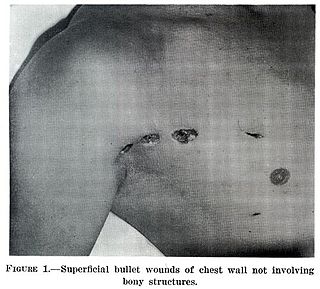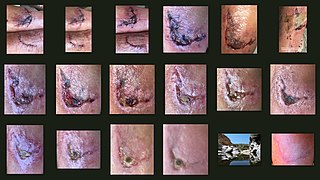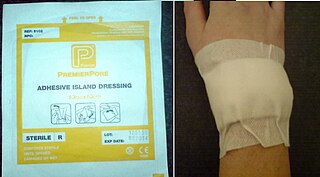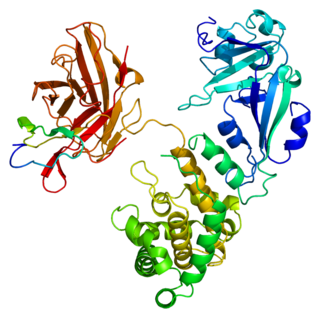Antiseptics are antimicrobial substances that are applied to living tissue/skin to reduce the possibility of infection, sepsis, or putrefaction. Antiseptics are generally distinguished from antibiotics by the latter's ability to safely destroy bacteria within the body, and from disinfectants, which destroy microorganisms found on non-living objects.

Calendula, is a genus of about 15–20 species of annual and perennial herbaceous plants in the daisy family Asteraceae that are often known as marigolds. They are native to southwestern Asia, western Europe, Macaronesia, and the Mediterranean. Other plants are also known as marigolds, such as corn marigold, desert marigold, marsh marigold, and plants of the genus Tagetes. The genus name Calendula is a modern Latin diminutive of calendae, meaning "little calendar", "little clock" or possibly "little weather-glass". The common name "marigold" refers to the Virgin Mary. The most commonly cultivated and used member of the genus is the pot marigold. Popular herbal and cosmetic products named 'calendula' invariably derive from C. officinalis.

A scar is an area of fibrous tissue that replaces normal skin after an injury. Scars result from the biological process of wound repair in the skin, as well as in other organs and tissues of the body. Thus, scarring is a natural part of the healing process. With the exception of very minor lesions, every wound results in some degree of scarring. An exception to this are animals with complete regeneration, which regrow tissue without scar formation.

Scarifying involves scratching, etching, burning / branding, or superficially cutting designs, pictures, or words into the skin as a permanent body modification. In the process of body scarification, scars are formed by cutting or branding the skin by varying methods, to purposely influence wound healing to scar more and not scar less. Scarification is sometimes called cicatrization.

A wound is a type of injury which happens relatively quickly in which skin is torn, cut, or punctured, or where blunt force trauma causes a contusion. In pathology, it specifically refers to a sharp injury which damages the dermis of the skin.

Wound healing is a complex process in which the skin, and the tissues under it, repair themselves after injury. In this article, wound healing is depicted in a discrete timeline of physical attributes (phases) constituting the post-trauma repairing process. In undamaged skin, the epidermis and dermis form a protective barrier against the external environment. When the barrier is broken, a regulated sequence of biochemical events is set into motion to repair the damage. This process is divided into predictable phases: blood clotting (hemostasis), inflammation, tissue growth (proliferation), and tissue remodeling (maturation). Blood clotting may be considered to be part of the inflammation stage instead of a separate stage.

Silver sulfadiazine, sold under the brand Silvadene among others, is a topical antibiotic used in partial thickness and full thickness burns to prevent infection. Tentative evidence has found other antibiotics to be more effective and therefore it is no longer generally recommended.

A dressing is a sterile pad or compress applied to a wound to promote healing and protect the wound from further harm. A dressing is designed to be in direct contact with the wound, as distinguished from a bandage, which is most often used to hold a dressing in place. Many modern dressings are self-adhesive.

Venous ulcers are wounds that are thought to occur due to improper functioning of venous valves, usually of the legs. They are the major occurrence of chronic wounds, occurring in 70% to 90% of leg ulcer cases. Venous ulcers develop mostly along the medial distal leg, and can be painful with negative effects on quality of life.
A chronic wound is a wound that does not heal in an orderly set of stages and in a predictable amount of time the way most wounds do; wounds that do not heal within three months are often considered chronic. Chronic wounds seem to be detained in one or more of the phases of wound healing. For example, chronic wounds often remain in the inflammatory stage for too long. To overcome that stage and jump-start the healing process a number of factors need to be addressed such as bacterial burden, necrotic tissue, and moisture balance of the whole wound. In acute wounds, there is a precise balance between production and degradation of molecules such as collagen; in chronic wounds this balance is lost and degradation plays too large a role.
The history of wound care spans from prehistory to modern medicine. Wounds naturally heal by themselves, but hunter-gatherers would have noticed several factors and certain herbal remedies would speed up or assist the process, especially if it was grievous. In ancient history, this was followed by the realisation of the necessity of hygiene and the halting of bleeding, where wound dressing techniques and surgery developed. Eventually the germ theory of disease also assisted in improving wound care.

Heparin-binding EGF-like growth factor (HB-EGF) is a member of the EGF family of proteins that in humans is encoded by the HBEGF gene.
Becaplermin is a cicatrizant, available as a topical gel. Regranex is a human platelet-derived growth factor indicated along with good wound care for the treatment of lower extremity diabetic neuropathic ulcers. It is also known as "platelet-derived growth factor BB".
Artificial skin is a collagen scaffold that induces regeneration of skin in mammals such as humans. The term was used in the late 1970s and early 1980s to describe a new treatment for massive burns. It was later discovered that treatment of deep skin wounds in adult animals and humans with this scaffold induces regeneration of the dermis. It has been developed commercially under the name IntegraTM and is used in massively burned patients, during plastic surgery of the skin, and in treatment of chronic skin wounds.
The collagen gel contraction assay is a type of wound contraction. It is performed using the dermal equivalent model, which consists of dermal fibroblasts seeded into a collagen gel.
Wound bed preparation (WBP) is a systematic approach to wound management by identifying and removing barriers to healing. The concept was originally developed in plastic surgery. during the year 2000, the concept was applied to systematizing the treatment of chronic wounds. The 2000 proposals recommended that wound management address the identifiable impediments to healing in order to achieve more successful outcomes. Three publications appeared that year that focused on the concept of managing the healing processes of a wound exudate, bioburden and devitalised tissue. Initially, emphasis was placed on debridement, moisture balance and bacterial balance as the three guiding principles of good wound care, while at the same time recognising that the provision of care includes a vast array of patient, clinical and environmental variables.
Dermal fibroblasts are cells within the dermis layer of skin which are responsible for generating connective tissue and allowing the skin to recover from injury. Using organelles, dermal fibroblasts generate and maintain the connective tissue which unites separate cell layers. Furthermore, these dermal fibroblasts produce the protein molecules including laminin and fibronectin which comprise the extracellular matrix. By creating the extracellular matrix between the dermis and epidermis, fibroblasts allow the epithelial cells of the epidermis to affix the matrix, thereby allowing the epidermal cells to effectively join together to form the top layer of the skin.

Aquaphor is a brand of over-the-counter (OTC) skin care ointments manufactured by Beiersdorf Inc., an affiliate of Beiersdorf AG. Aquaphor is offered in four product ranges: There are two skin protectant ointments. Aquaphor Original Ointment, used as a compounding agent and Aquaphor Advanced Therapy Healing Ointment, sold in mass retail outlets. The other product ranges include: Aquaphor Lip Repair and Lip Repair + Protect SPF 30, and Aquaphor Baby.

Sandalore is a synthetic sandalwood odorant with odor in some ways similar to sandalwood and consequently used in perfumes, emollients, and skin cleaning agents. Sandalore, and the similar brahmanol, have been identified as agonists of the cutaneous olfactory receptor OR2AT4, and found to induce strong Ca2+ signals in cultured human keratinocytes. The long-term stimulation of keratinocytes with Sandalore positively affected cell proliferation and migration, and regeneration of keratinocyte monolayers in an in vitro wound scratch assay (i.e., sandalore stimulation also enhanced epidermal "wound healing" in human skin organ cultures). Natural sandalwood oil and other synthetic sandalwood odorants did not have the same effect.










